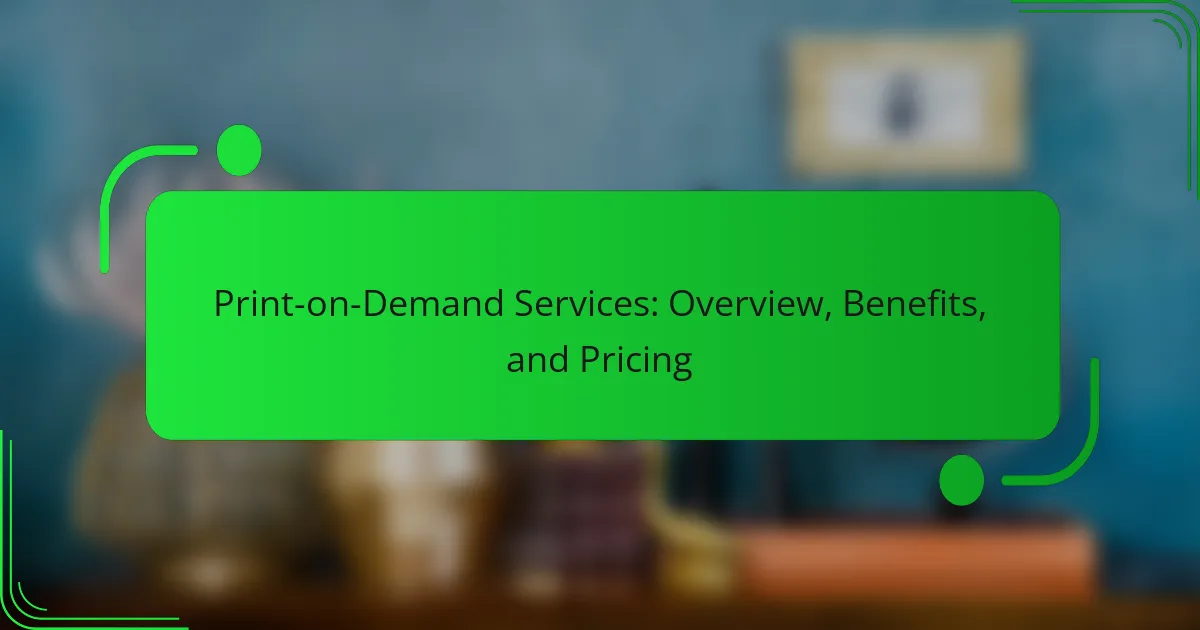eBook formatting services enhance the readability and professionalism of digital books. This article explores essential features like file type conversion and layout design, typical costs ranging from $100 to $500, and best practices for ensuring compatibility across devices. It also addresses common challenges authors face during formatting and offers guidance on selecting the right service provider.
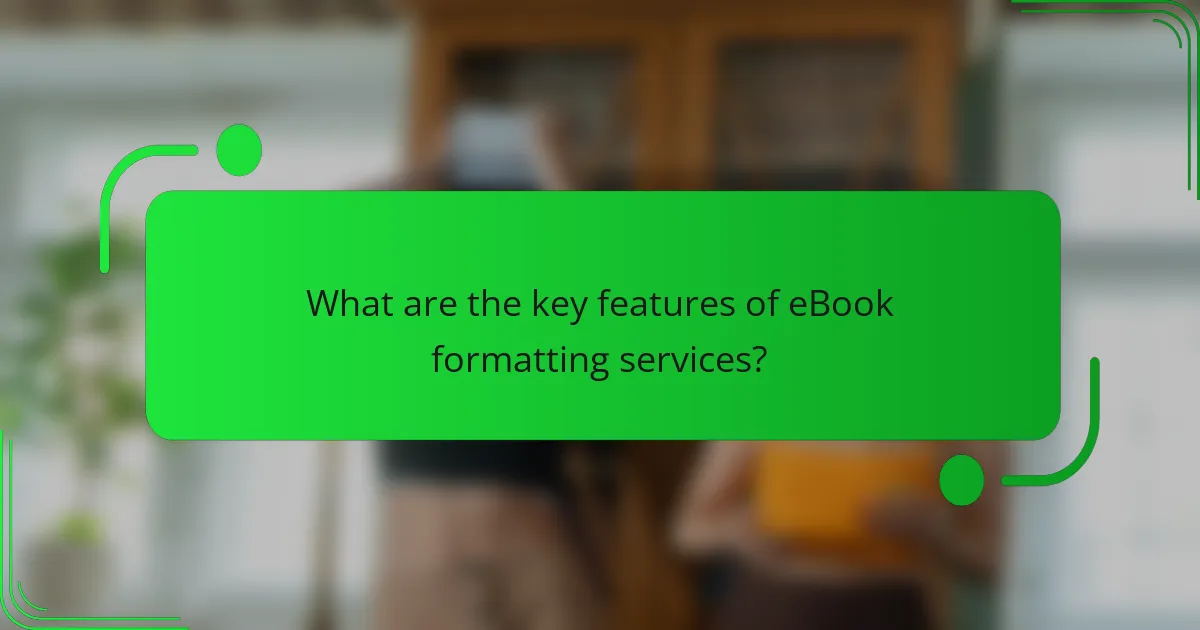
What are the key features of eBook formatting services?
eBook formatting services offer essential features that enhance the readability and professionalism of digital books. Key features include file type conversion, layout design, and compliance with various eBook platforms.
File type conversion ensures compatibility with formats like EPUB, MOBI, and PDF. Layout design focuses on optimizing text and images for different devices, providing an engaging user experience. Compliance with eBook platforms guarantees that the formatted book meets the specific requirements of retailers like Amazon Kindle and Apple Books.
Additional features may include metadata optimization, which enhances discoverability, and interactive elements, such as hyperlinks and multimedia integration. These aspects contribute to the overall quality and marketability of the eBook.
How do eBook formatting services enhance readability?
eBook formatting services enhance readability by ensuring consistent layout, proper font selection, and optimized navigation. These services improve user experience by providing clear chapter divisions, effective use of white space, and compatibility across devices. Enhanced readability increases engagement and retention, making it easier for readers to consume content.
Which platforms are commonly used for eBook formatting?
Common platforms for eBook formatting include Adobe InDesign, Scrivener, Calibre, and Vellum. These tools offer various features tailored for different formatting needs. Adobe InDesign is known for its professional layout capabilities, while Scrivener excels in manuscript organization. Calibre provides free options for conversion and management, and Vellum is popular for its user-friendly interface, especially among Mac users. Each platform has unique attributes that cater to specific formatting requirements, making them suitable for various authors and publishers.
What formats do eBook formatting services support?
eBook formatting services support various formats including EPUB, MOBI, PDF, and DOCX. These formats cater to different e-readers and platforms, ensuring compatibility and ease of use. EPUB is widely used for its reflowable content, while MOBI is preferred for Kindle devices. PDF maintains the original layout, making it suitable for print-like presentations. DOCX is often used for initial manuscript formatting before conversion.
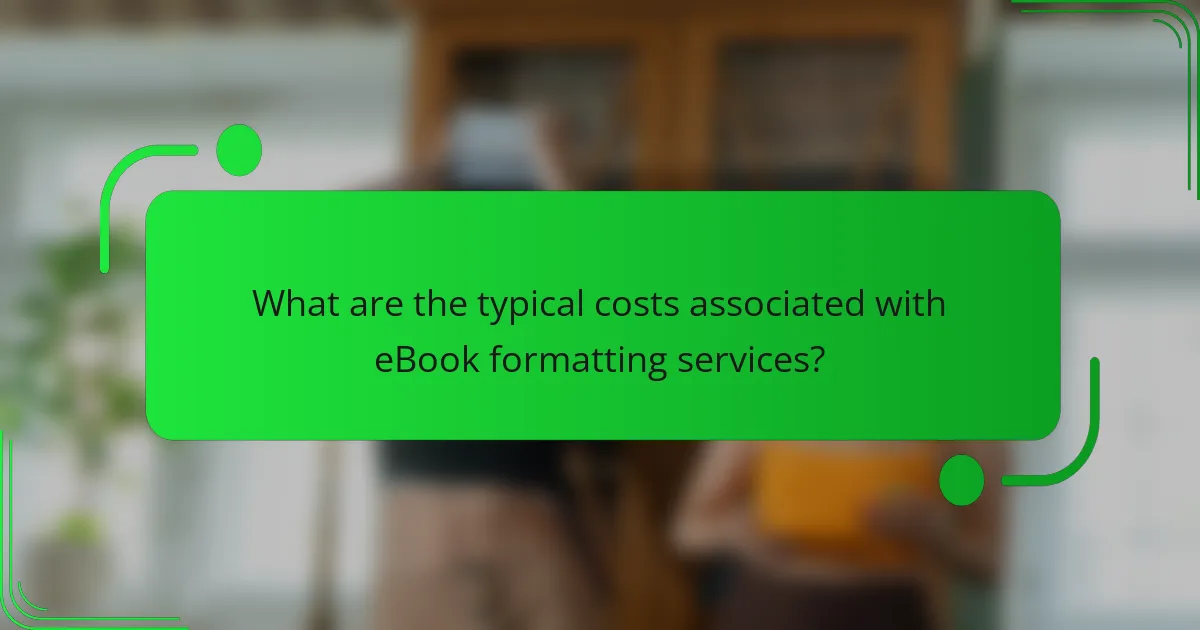
What are the typical costs associated with eBook formatting services?
Typical costs for eBook formatting services range from $100 to $500, depending on complexity and service provider. Factors influencing pricing include the length of the eBook, the level of customization required, and the specific formats needed, such as EPUB or MOBI. Basic formatting for shorter eBooks typically costs less, while comprehensive services, including design and conversion, may be at the higher end.
How do pricing models vary across different service providers?
Pricing models for eBook formatting services differ significantly among providers, often based on complexity and service scope. Common models include flat-rate pricing, hourly rates, and tiered packages. Flat-rate pricing offers a fixed cost for specific services, making budgeting straightforward. Hourly rates can vary widely, typically ranging from $25 to $100 per hour, depending on the provider’s expertise. Tiered packages provide different levels of service at varying price points, catering to diverse author needs. Overall, understanding these models helps authors choose the right service for their budget and requirements.
What factors influence the cost of eBook formatting?
Several factors influence the cost of eBook formatting, including the complexity of the content, the number of formats required, and the level of customization. Additional elements such as the length of the manuscript and the inclusion of images or interactive features can also significantly impact pricing.
Are there budget-friendly options for eBook formatting?
Yes, there are budget-friendly options for eBook formatting. Many freelance platforms offer affordable services, typically ranging from $50 to $200 depending on complexity. Additionally, DIY tools like Reedsy and Scrivener allow authors to format their eBooks at no cost, provided they invest time in learning the software. Using templates can also reduce costs while ensuring a professional appearance.
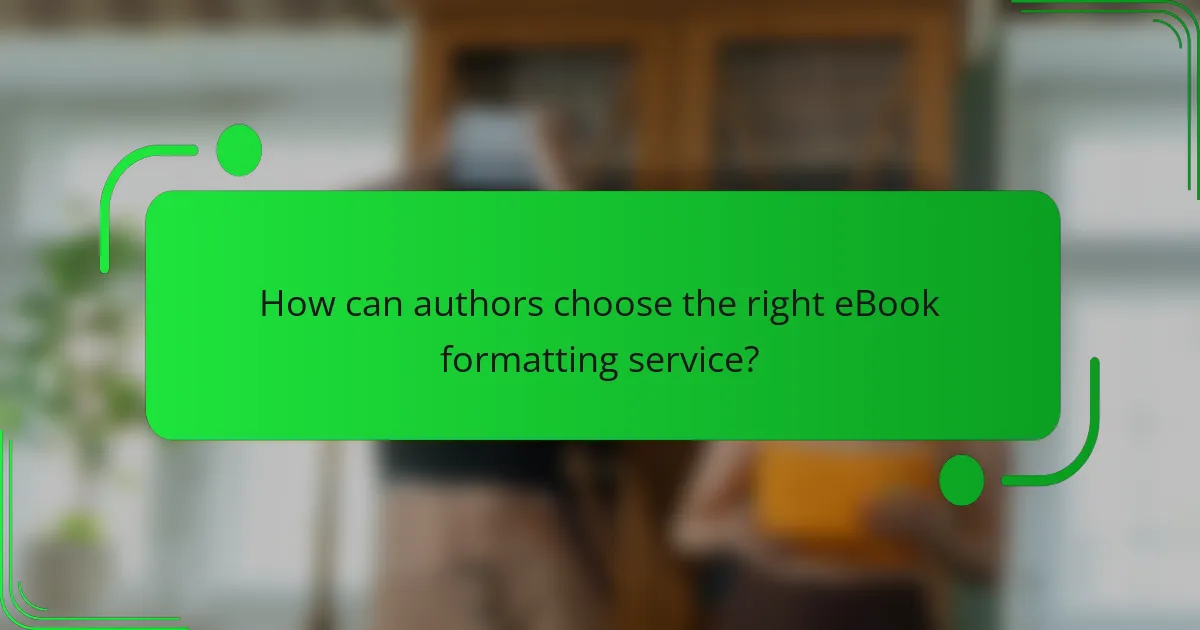
How can authors choose the right eBook formatting service?
Authors should evaluate eBook formatting services based on quality, cost, and customer support. Consider services that offer tailored formatting options suitable for various platforms. Compare pricing models, including flat fees versus per-page rates. Look for user reviews to gauge reliability and turnaround times. Prioritize services that provide a sample of previous work to assess quality.
What should authors look for in a formatting service provider?
Authors should prioritize experience, customer reviews, and customization options when selecting a formatting service provider. Experienced providers understand various eBook formats and distribution channels. Positive customer reviews indicate reliability and quality. Customization options ensure the final product aligns with the author’s vision. Additionally, check for transparent pricing and turnaround times to avoid unexpected costs.
Which questions should authors ask before hiring a formatting service?
Authors should ask key questions to ensure they hire the right formatting service. Consider these essential inquiries:
1. What specific formatting styles do you specialize in?
2. Can you provide examples of your previous work?
3. What is your turnaround time for projects?
4. What are your pricing structures and payment terms?
5. Do you offer revisions or adjustments after initial formatting?
6. How do you handle different eBook platforms and their requirements?
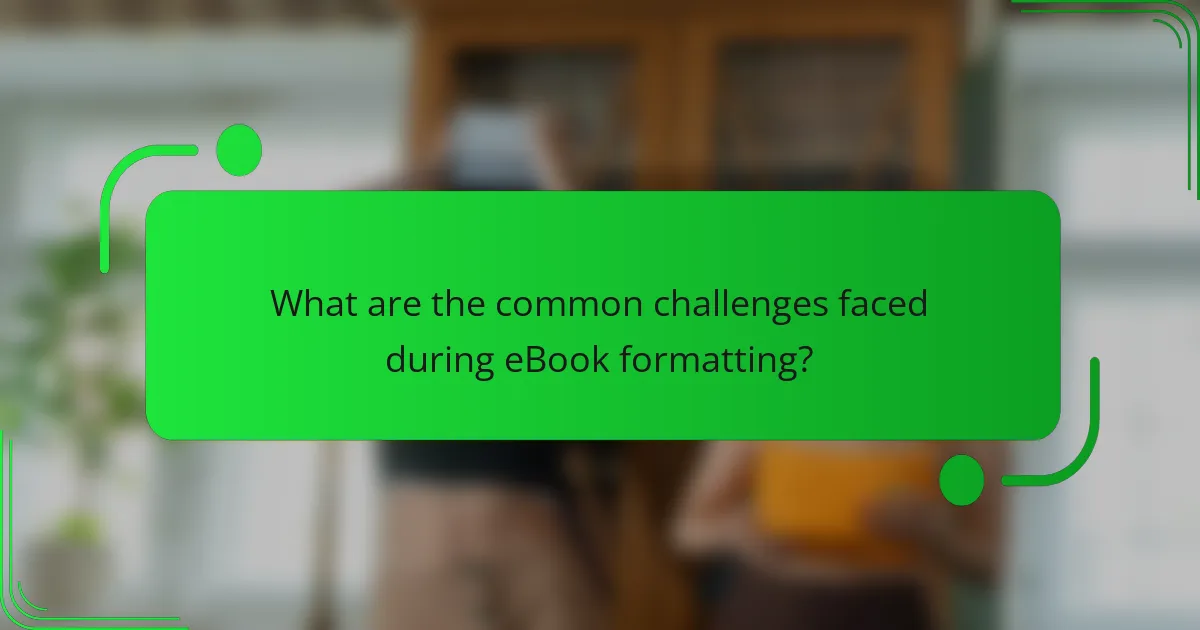
What are the common challenges faced during eBook formatting?
Common challenges during eBook formatting include inconsistent formatting, file compatibility issues, and layout problems. These challenges can lead to poor user experience and accessibility issues. Ensuring consistent styles across devices is crucial, as is optimizing images for different formats. Additionally, managing metadata and ensuring proper conversion between formats can be complex, requiring attention to detail to avoid errors.
How can authors overcome formatting issues?
Authors can overcome formatting issues by utilizing professional eBook formatting services. These services provide expertise in various formats, ensuring compatibility across devices. Costs vary based on complexity, typically ranging from $50 to $300. Best practices include choosing the right service based on specific needs, such as genre or format type, and allowing ample time for revisions.
What are the most frequent mistakes to avoid in eBook formatting?
Common mistakes to avoid in eBook formatting include inconsistent font usage, improper image placement, neglecting metadata, and ignoring device compatibility. These errors can result in a poor reading experience and reduced accessibility. Ensuring uniformity in fonts enhances readability, while correctly placed images maintain visual appeal. Proper metadata helps with discoverability and organization across platforms. Lastly, testing on various devices ensures compatibility and a seamless user experience.
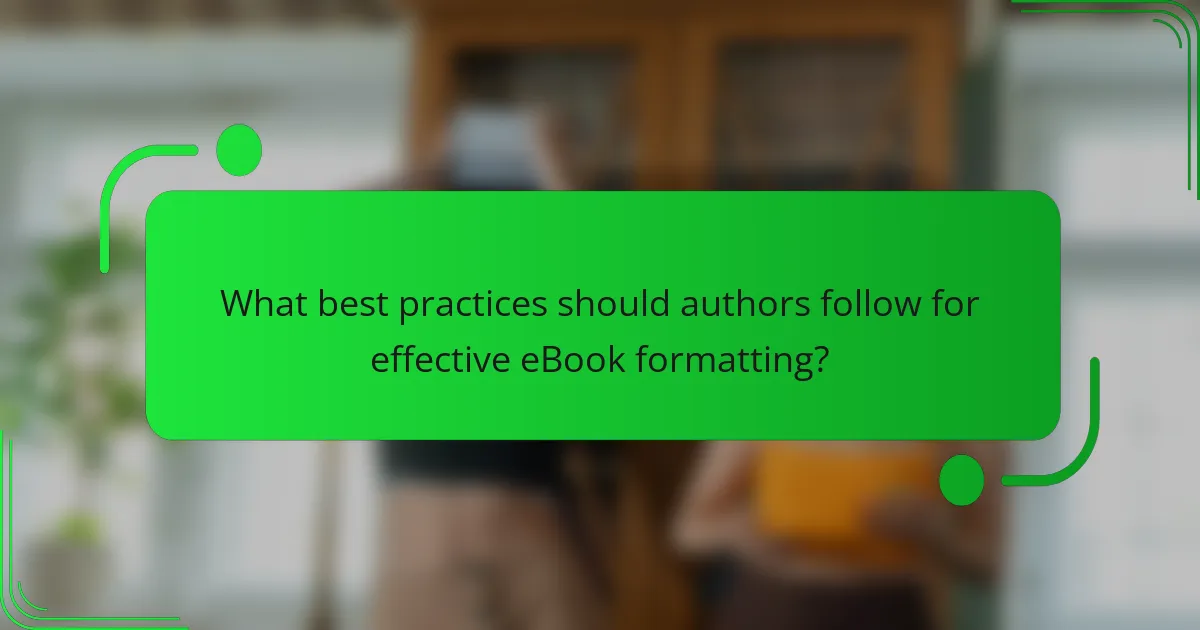
What best practices should authors follow for effective eBook formatting?
Authors should follow best practices for eBook formatting to ensure readability and compatibility across devices. Key practices include using a consistent style for headings and fonts, optimizing images for quick loading, and ensuring proper alignment and spacing.
1. Choose a standard eBook format like EPUB or MOBI.
2. Use styles for headings, paragraphs, and lists for consistency.
3. Optimize images to reduce file size without sacrificing quality.
4. Test on multiple devices to ensure proper display.
Following these guidelines enhances the reader’s experience and increases the eBook’s accessibility.
How can authors ensure their eBooks are compatible with multiple devices?
Authors can ensure their eBooks are compatible with multiple devices by using standardized formatting and testing across platforms. Key practices include utilizing formats like EPUB or MOBI, which adapt to various screen sizes. Authors should also use responsive design principles, ensuring text and images adjust fluidly. Regularly testing eBooks on different devices and reader apps helps identify compatibility issues early. Lastly, employing professional eBook formatting services can enhance quality and ensure compliance with device specifications.
What tools can assist in the eBook formatting process?
Tools that can assist in the eBook formatting process include software like Adobe InDesign, Scrivener, and Calibre. These tools offer features for layout design, file conversion, and formatting consistency. Each tool varies in cost and functionality, catering to different user needs. For instance, Adobe InDesign is known for its advanced design capabilities, while Calibre is a free option suitable for basic formatting tasks.
What are the latest trends in eBook formatting for 2025?
The latest trends in eBook formatting for 2025 emphasize interactivity, enhanced accessibility, and multimedia integration. Readers increasingly prefer immersive experiences, leading to the inclusion of audio, video, and interactive elements within eBooks. Additionally, formatting tools are evolving to support various screen sizes, ensuring compatibility across devices. Enhanced accessibility features, such as adjustable text sizes and voice-over capabilities, are becoming standard to cater to diverse audiences. Furthermore, the rise of artificial intelligence is shaping personalized formatting options, allowing customized reading experiences based on user preferences.
How can authors optimize their eBooks for better sales performance?
Authors can optimize their eBooks for better sales performance by focusing on formatting, pricing, and marketing strategies. Proper formatting enhances readability and ensures compatibility across devices. Consider hiring professional eBook formatting services to achieve high-quality results.
Key options include fixed layout for illustrated content and reflowable format for text-heavy books. Costs for these services can vary widely, typically ranging from $50 to $500 depending on complexity. Best practices involve using consistent fonts, clear headings, and proper image resolution to improve user experience.
Engaging cover designs and effective metadata also play crucial roles in attracting potential readers. Regularly updating eBook content and utilizing promotional strategies can further enhance visibility and sales performance.


